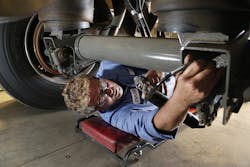A successful business strategy always includes knowing the customer’s needs. With that knowledge, services can be offered that will keep the customer happy. This is especially true when it comes to the business of equipment maintenance and repairs. Nowadays, it’s more important than ever to create a synergy between a fleet and a repair facility.
The trucking industry is currently facing many challenging maintenance issues that are stretching a fleet’s capacity to efficiently maintain its vehicles. Fleets are looking for reliable repair facilities to handle their overflow repairs and breakdowns. All parties concerned have to clearly communicate needs and information.
Vehicle Maintenance Reporting Standard (VMRS) can be a big help with this. It communicates in a concise method of easy-to-use codes that streamlines communication between a service provider and a fleet. Plus, it makes reporting easier.
Maintained by the Technology & Maintenance Council (TMC), VMRS is used by most fleets through their own in-house software or a maintenance software provider. VMRS has been the accepted maintenance language of most major maintenance software providers for many years and continues to be an important part of their maintenance software products.
All about the Codes
VMRS provides much more than the nine-digit part code for which it’s best known. There are complementary codes for such matters as determining why a part failed, what labor the technician performed and the reason the equipment was initially brought in for repairs.
VMRS is organized into Code Keys – data sets of individual codes that describe a given maintenance function. The codes are a brief description of parts and labor tasks that make it easy for the users to document that the proper work was performed.
It bears noting that VMRS is a dynamic standard, meaning it is constantly being revaluated to meet equipment user needs. Currently, TMC is planning to propose adoption of a new set of codes designed to facilitate a maintenance event by communicating to the fleet customer the status of repairs during the course of the maintenance event.
The new codes, if approved by TMC’s membership, will be found in Code Key 24: Maintenance Status. Examples of the proposed new codes are: Waiting on Bay/Technician, Diagnostics in Progress and Parts on Order.
Structure
Along with being the standard method for communicating maintenance information within a service organization, VMRS is also a great way for vendors to communicate with their customers. VMRS uses precise codes for describing and tracking any type of repair while defining maintenance functions in a user friendly format that can be employed by any maintenance facility.
VMRS helps eliminate the need for extensive written communication with all the inherent problems normally associated with the written word. The VMRS coding structure encompasses most equipment found within today’s transportation activities, including trucks, tractors, forklifts, shop equipment and off-road.
A Look into Things
Fleets using VMRS have a standard by which they can analyze their entire maintenance operation and costs, including historical data. VMRS helps pinpoint areas of excess expense and premature failure, increasing efficiency and equipment utilization.
It also enables benchmarking of equipment experience and expenses, as well as the overall performance of the maintenance department.
Furthermore, VMRS can assist a fleet in determining the effectiveness of its PM program. It can answer such questions as:
- Are PM’s performed too often or not often enough?
- Should PM intervals be modified based on specific failures reported through true maintenance reporting and not on anecdotal information?
VMRS codes help track labor distribution, covering both direct and indirect labor. Moreover, VMRS provides complete details on parts usage, identifying which part should be inventoried and which should be procured on an “as needed” basis.
Its Muscle
In short, the power of VMRS – which was established more than 35 years ago – is that it:
- Provides a logical, easy-to-use maintenance language that ties together all operational information a fleet needs to operate profitably.
- Creates a single process to document when, why and how maintenance is performed on equipment.
- Improves parts inventory control and helps identify where the maintenance money is spent.
- Connects all parties within the equipment repair ecosystem.
Kenneth Calhoun is vice president of customer relations for Truck Centers of Arkansas (www.truckcentersar.com), a full-service dealership headquartered in North Little Rock, Ark. He serves as a service provider director at large on TMC’s board of directors and is the immediate past chairman of TMC’s S.16 Service Provider Study Group. TMC (www.trucking.org/Technology_Council.aspx) is North America’s premier technical society for truck equipment technology and maintenance professionals.
About the Author
Kenneth Calhoun
Technology & Maintenance Council (TMC)
Vice President, Customer Relations, Truck Centers of Arkansas; Service Provider Director at Large, Technology & Maintenance Council (TMC) Board of Directors; Immediate Past Chairman, TMC S.16 Service Provider Study Group
